FIG 2.
Enhanced growth of tubular adenomas in Wv/Wv; p27+/− and Wv/Wv; p27−/− mice. Hematoxylin and eosin (H&E)-stained slides showing representative ovarian and tumor morphology from 4- to 6-month-old mice with Wv and p27 mutant genotypes. (A) Typical example of an ovary enclosed in a bursa and associated oviduct from a wild-type mouse. (B) Typical ovarian tubular adenoma from a 4-month-old Wv/Wv mouse. (C and D) Examples of ovarian tumors from Wv/Wv; p27+/− mice. (E and F) Examples of ovarian tumors from Wv/Wv; p27−/− mice. (G) Tumor sizes (areas) were estimated and are shown as means with standard deviations, using Zeiss Axiovision software, from slides near the middle section (with the greatest width) of ovarian tumors. P values were calculated by a nonpaired Student t test. **, P < 0.0001; ***, P < 0.001. (H) Example of Ki67 staining of a wild-type ovary. (I) Example of Ki67 staining of a Wv/Wv ovarian tubular adenoma. (J) Example of Ki67 staining of a Wv/Wv; p27−/− ovarian tubular adenoma. (K) Based on the analysis of at the least 5 cases in each category, the percentages of Ki67-positive epithelial cells among either ovarian surface or tubular adenoma epithelial cells were estimated for wild-type (WT), Wv/Wv, Wv/Wv; p27+/−, and Wv/Wv; p27−/− mice and are shown as averages and ranges. The increases in Ki67 cells were statistically significant (P < 0.005) in comparisons between wild-type and Wv/Wv, Wv/Wv; p27+/−, and Wv/Wv; p27−/− mice. The difference between Wv/Wv and Wv/Wv; p27+/− or Wv/Wv; p27−/− mice was also significant, but no significant difference was found between Wv/Wv; p27+/− and Wv/Wv; p27−/− mice.

